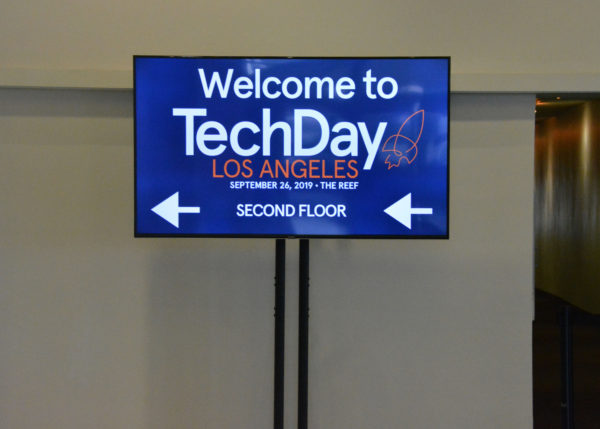by Dot Cannon

A sign welcomes visitors to TechDay Los Angeles, 2019.
We’ve heard the phrase many times. “Keynote speech”. But, where does that come from?
At the start of TechDay Online, on Tuesday morning, TechDay HQ President Walter Charnizon explained.
“The keynote was the note the lead violin would play, when (the orchestra would) come out on the stage,” he said. “It’s the note to which everyone can (attune to create a harmonious event).”
At 9:00 that morning, bestselling author and TEDx speaker Jeff Butler had already set that high note.
TechDay is the world’s largest producer of startup events. As Walter explained in our previous interview, TechDay normally hosts annual events in three cities: London, New York and Los Angeles. But the pandemic has forced the show into a virtual format this year.
And all three regions are represented in TechDay Online, which runs as a completely virtual event from now through Thursday, November 19th.
“This is our maiden voyage (as an all-virtual event),” Walter commented as he introduced Jeff’s opening keynote, “Redefining Leadership in the New Decade”.
A calculated risk

(Royalty-free image by Free-Photos from Pixabay.)
In his opening comments, Jeff addressed the subject of workplace stereotyping. Initially, as good leaders often do, he took a gamble.
He asked his audience: who identified as “Generation X”? Who was a Baby Boomer? Who was a millennial?
And for each group, he presented stereotypes.
“Are you skeptical, tend to see the glass half-empty, or go at it alone?” Jeff asked the “Gen-Xers”.
Baby Boomers, meanwhile, were characterized as “rule followers, loyal, out of touch and self-sacrificing”.
And millennials? They got, “entitled, lazy, love technology”.
But then, Jeff said, all of these characterizations were meant as sarcasm.
“There’s something really bizarre that takes place when you work with different generations,” he explained. “One of the difficulties we have about leadership (is), you cannot rely on stereotypes to lead a generation.”
A metaphor for traveling forward

(Royalty-free image by Malachi Witt from Pixabay .)
Jeff continued his keynote by likening a leadership position to driving a vehicle.
“When you look at leadership, it’s a really easy analogy,” he said. “Most (employees) are along for the ride. Your job, as a leader, is to turn those people into drivers. (Or, better, navigators.)”
He’d learned a lot about leadership, he continued, after his grandfather asked an unexpected question. At the time Jeff was living in California, as a “tech kid” whose parents had both built software companies.
“My grandfather said, out of the blue, ‘I’m going to (Massachusetts)–do you want to come live with me?'” Jeff said.
And although Jeff didn’t know his grandfather well at that point, he took him up on the offer. This decision amounted to entering a completely new environment: his grandfather had made his living by building houses.
“I learned a lot along the way, (about) working with different generations,” Jeff said.
One of those lessons was the error of stereotypes. His grandfather, now in his eighties, is tech-savvy.
(“He does YouTube, and texting,”) Jeff explained.
Navigation and expectations

(Royalty-free image by William Iven from Pixabay.)
Expectations, Jeff continued, would drive a company’s culture.
“When you’re setting expectations, always open the door,” he said. “Say, ‘hey, this is how we’re doing this (now, do you have any ideas for improvement)?’ That builds trust.”
And trust, he continued, was key to building a company culture where employees–and new ideas–thrive.
“You have people who are no longer drivers. They’re making decisions and looking at the company as if it (were) their own.”
But promoting people to leadership positions, Jeff said, isn’t necessarily what every employee wants.
“Not all engineers want (to be leaders. They get promoted and can get depressed–because they became engineers so they could make things).”
Spotting “navigator” potential, Jeff said, involved looking at how employees responded to the workplace.
(“Do they have goals past their current position? And curiosity outside of their role? Are they becoming a team resource?”)
Taming the “elephant in the room”

)Royalty-free image by StartupStockPhotos from Pixabay .)
Jeff recommended verbally recognizing age differences upfront, when leading a team.
“Once you address the difference in age, the tension begins to relax a little bit,” he said.
And that relaxation could lead to trust, and to team members becoming new leaders.
(“And once that happens, there are other areas in which they grow,”) he said. “They start looking at their lives and saying, ‘what else can I do in my life, when I’m a ‘passenger’?’ (They may make improvements in their personal life, or their health.). From passenger, to driver, to navigator.”
After Jeff’s keynote, Walter commented on the easiness of falling into the trap of age-related stereotyping.
“People said to me, ‘Don’t you find it hard to work with all these young people?'” he commented.
“Nothing could be further from the truth. There are Baby Boomers who are jerks to work with, and there are millennials who are jerks to work with.”
Takeaways from a “unicorn”
As Walter commented, Jeff’s keynote speech had set an opening “high note” for Day One of TechDay Online. The day’s additional features continued in harmony.

(Royalty-free image by StartupStockPhotos from Pixabay.)
In TechDay Online’s first “Ask Me Anything” session, “Ask Me Anything About Scaling From Startup to Unicorn”, Brex Head of Partnerships Larissa Maranhao offered both encouragement and realism to startup founders.
“Why are you and your cofounder the right ones to tackle (the particular problem your startup addresses)?” she asked.
Brex, Larissa told her audience, had learned that lesson from experience.
Initially, they started off as a fintech company. Then, the founders started learning about virtual reality–and decided to go in that direction. But banks wouldn’t give them access to capital. And, Larissa said, they didn’t know much about VR. Financial technology was their area of expertise. So the company pivoted back into fintech.
“Our culture didn’t shift, as much as it evolved,” Larissa said. “From the very beginning, we were very aware of what we are.”
Larissa also advised her audience to be tenacious. She’d lived in San Francisco for three years, she said, and had seen talented people get very upset when investors rejected their pitches.
“(In) the business of venture capital, you will invest in a lot of companies and a few of them will succeed,” Larissa explained. “You meet with ten times (more companies than you will invest in.). Your odds of getting a ‘yes’ from an investor are ten percent.
“The bottom line is, don’t take a ‘no’ from an investor that seriously.”
AI, pitches and talks

(Royalty-free image by StartupStockPhotos from Pixabay.)
Since 6:00 am, Pacific time, networking had been available for TechDay Online attendees. Participants filled out an online profile and could attend networking sessions. In addition, an Ai-enabled system matched guests who might like to meet.
Meanwhile, TED-style “TechDayTalks” sessions were available on demand. In addition, three virtual “startup stages” and a “pitchfest” were in operation. Meanwhile, we counted more than 160 participants in the virtual “Exhibitors” area.
And even with the virtual format, we felt sure we were going to miss something! (Fortunately, presentations are recorded and will be made available at a later date.)
Innovators in the “boxing ring”

(Royalty-free image by Gerd Altman from Pixabay.)
Day One’s program ended with an afternoon “Ask Me Anything About Accelerators, Incubators, Labs and Studios” session, featuring Cela Co-Founder John Lynn.
“Remember the very first Tech Day we did?” asked Expert Dojo “Head Honcho” (as his LinkedIn profile describes him!) Brian McMahon at the start of the hour. “We brought in a boxing ring. (An actual one, with startups pitching on one side and investors on the other.)
“Those messed-up times! I miss them.”
“I miss the live (events too), we’ll get back to them,” Walter replied.
“Till then, this will be our boxing ring.”
John told the audience that Cela runs the only global accelerator summit in the world: the Cela Summit. He and Brian explored the various ways startup founders might connect with venture capitalists.
A clear preliminary picture

(Royalty-free Image by StartupStockPhotos from Pixabay.)
A major takeaway from this particular session: know what success looks like.
“Should a startup go to an accelerator (or not)?” Brian asked.
“I think the answer to that is, if they know what they want,” John replied. “Unless (you’re) coming together to an outcome you’re committed to (you won’t get the results you’d like).”
“Every single person coming to an accelerator needs to be looking at, ‘What does my end objective look like?'” Brian said.
A question that came up early, in this particular “Ask Me Anything” session: “Why is having a co-founder important?”
“When you’re building any company, you’re building a network of relationships,” John responded. “There needs to be a foundation.”
Backup was an area which Brian mentioned, as well.
“There is a moment where all venture capitalists are terrified that, if this person gets run down…all our money is gone.”
Another attendee wanted to know whether age, in funding startups, was still a bias.
“Historically, to be clear, most successful founders achieve their first successful venture later in life,” John said.
However, he added, he saw “all kinds of identity traits that are causing bias”.
“The source…seems to be the way that systems are set up. It’s something that accelerators should be first to be better at.”
“I know 20-year-olds…who are going on seventy (and whom I wouldn’t fund),” Brian said. “Age, for me, is an irrelevancy on a million different levels.
“I’m 51 and I’m crushing it…
“Just be a beast.”
Day Two of TechDay Online starts at 6:00 am, Pacific time, on Wednesday, November 18th with exhibiting and networking sessions. Keynote 2, “Second Annual State of the NY Ecosystem”, begins at 8:00 am, PST. Here’s the link for information.
